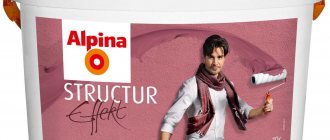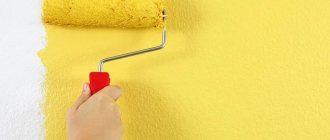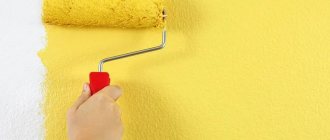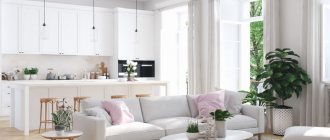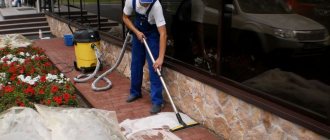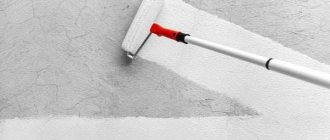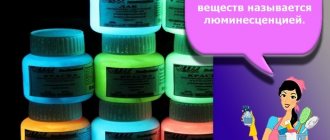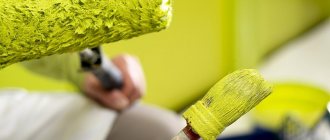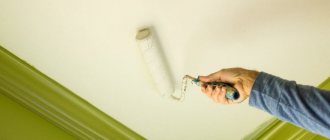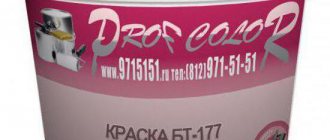SHARE ON SOCIAL NETWORKS
FacebookTwitterOkGoogle+PinterestVk
One of the popular finishing materials for decorating a room is paint. There are a large number of them, and they all differ in type and properties. Each type has certain application nuances. Ceiling paint also has a number of such moments. How to apply it correctly, what tools are best to use for this and what you should pay attention to when performing work will be discussed in this article.
If you choose the right tools and materials for painting the ceiling, you can achieve the perfect result without much effort.
Finishing features
Painting is a durable finishing option that, with low labor costs, will allow you to obtain a beautiful, smooth surface. The material will not fade, peel or wear off. A well-chosen solution will help optically change the incorrect configuration of the room.
Material for dyeing Source sdelaipotolok.com
Decorative finishing gives a textured effect. There are 4 types of coatings:
- Glossy. The enamel shines, reflects light well and visually enlarges a small space. The higher the degree of smoothness, the more durable the material. The varnished texture emphasizes the slightest cracks and irregularities, so the surface must be perfectly prepared before application.
- Matte. Velvety ceiling paint does not shine and hides defects in the area. The porous structure of the coating absorbs dust and dirt, making the area above your head difficult to wash.
- Semi-gloss. The material has a light reflective effect and is not afraid of mechanical damage. Perfect for compact spaces, masks defects.
- Semi-matte. The slightly velvety finish is resistant to stains and wear.
Coating with varnish texture Source rusoboz.ru
The higher the hiding power, the fewer layers will be required to cover the base color. Manufacturers offer 4 classes, the details of which are indicated on the label. Ceiling paint with a coefficient of 1 will repaint a black base white in 2 approaches. At low rates, enamel consumption increases and the decorative effect of the finish is lost. Often the amount spent on expensive material is lower than that of cheap analogues.
Velvety covering over the head Source natjazhnye-potolki-rostov.ru
Mineral and polyvinyl acetate
These compositions are made on the basis of cement (slaked lime) and polyvinyl acetate (this is the well-known PVA glue). Mineral paints are usually used to decorate ceilings made of concrete panels: the service life of such a coating is not very long. The scope of use of PVA-based materials is dry rooms, because... The decorative layer created with their help is not hydrophobic.
Types of material
Ceiling decoration should be safe, beautiful and practical. The division of paints into types depends on the main component that binds the components of the mixture. There are 5 types of materials that are used to paint the space above your head.
Mineral
An inexpensive, odorless, water-based finish is a bit like whitewash. If you run your hand over the surface, a light mark remains on the skin. Paint is made from cement and slaked lime diluted in water. After drying, the elements create a thin, even film in the area above the head.
Mineral water-based paint for ceilings dries quickly. Before work, the surface is cleaned of old coating, leveled and cracks are sealed. Traditionally, the finish is produced in white. To obtain the desired shade, pigment paste is added to the composition.
Painting the ceiling Source sdelai-lestnicu.ru
Mineral water emulsion is used in rooms without humidity and temperature changes. The material is gradually washed away, so wet cleaning is contraindicated. When drops of water enter (flooding from neighbors), sloppy stains form in the area above your head.
Silicate
Ceiling paint based on liquid glass and office glue is easy to use. The inexpensive composition is ideal for use in dry rooms. Exposure to moisture gradually destroys the finish, reduces the color intensity, and a soap solution can completely wash off the coating. The safe, non-flammable material does not smell, so it is used in children's rooms and bedrooms.
The finish fits perfectly on concrete and plastered surfaces. The material does not interact with polymer compounds. If you need to repaint a colored (dark) ceiling, you will have to remove the coating. Due to low elasticity, the raw material is not able to mask cracks.
Silicone
Beautiful finishes are created using synthetic resins. The enamel covers the surface with a thin layer, protecting the ceiling from moisture and temperature changes. This type combines the advantages of mineral and organic paints, which allows it to be used in rooms with an aggressive environment (bathroom, kitchen).
Options for the ceiling Source sdelai-lestnicu.ru
The elastic coating repels water and allows air to pass through (“breathes”). After painting, the surface does not rot or mold. Antistatic properties prevent dust and dirt from accumulating on the ceiling. Silicone resins create a strong film that is not afraid of mechanical damage and does not burn in fire. The only drawback is the high cost.
Acrylic
The finish dries quickly and does not smell. Due to its viscosity, enamel fills cracks, so the surface is always beautiful and durable. The material contains water and acrylic resin, which:
- does not fade under the sun;
- does not fade from frequent cleaning;
- not picky about the type of detergents.
The raw materials can be used indoors with sudden temperature fluctuations and high humidity, so they will last for decades. The coating does not absorb foreign odors. To paint 6 squares, 1 liter of finishing is enough.
Acrylic compositions Source masterpotolok.com
Water-based acrylic ceiling paint comes in colored and white. If the palette does not have the desired shade, then tinting is done with a pigmenting paste. After drying, the color turns out to be slightly darker than indicated on the label.
Latex
Expensive paint based on latex polymer fits perfectly onto any surface shape. Due to its viscosity, the material penetrates into cracks up to 1.5 mm deep. The finish does not fade under the sun, is not destroyed by moisture and is not erased during cleaning. Antistatic properties repel dust and dirt, making cleaning easier.
Practical decoration of the area above the head Source sdelai-lestnicu.ru
Latex-based water-based ceiling paint is not afraid of scratches and abrasives. The material has excellent adhesion, so a beautiful glossy or matte surface will be obtained after one layer. The raw material allows air to pass through and does not retain condensation, which reduces drying to 2 hours.
Silicate
The basis of silicate paint is a mixture of liquid glass, talc and chalk. After application, a very hard and durable coating is formed on the surface, the service life of which reaches 15-20 years, even in the presence of unfavorable external conditions. Indoors, where there is virtually no aggressive impact on the finish, silicate paints can last an order of magnitude longer.
An important advantage of this finishing material is its high vapor permeability. As a result, water molecules can circulate freely in any direction, providing a microclimate that is favorable for humans indoors. In addition, the decorative layer will not peel off or become damp. It is still not recommended to use silicate paints in very damp rooms. But when choosing which paint is best to paint the ceiling in a room for water procedures or cooking, you need to pay special attention to silicate paints.
However, the specificity of liquid glass is such that due to its low elasticity, silicate paint is prone to cracking. This must be taken into account when looking for an option on what paint to paint the ceiling in an apartment in houses where walls and ceilings tend to shrink. Before applying this type of material, it is necessary to very carefully remove all traces of previous paint from the base (primarily this applies to organic finishes). In terms of moisture resistance, silicate paint is very similar to acrylate paint: it can be washed with a damp sponge and household chemicals.
Popular manufacturers
The variety of brands producing ceiling enamels in construction stores is great. The choice of paint depends on the personal preferences of the manufacturer, financial capabilities and the effect to be achieved. Among the popular ones, we highlight 8 manufacturers who have won the trust of users.
Tikkurila
The famous Finnish brand creates high quality finishes. The materials are used when working with problematic surfaces; they work well on putty, drywall and wood. The mixture contains substances with antibacterial properties that prevent the development of dangerous microflora and can be used in the bathroom and kitchen.
Finnish paints Source cmp24.com.ua
Oil and enamels
Along with water-based compositions, ceilings are sometimes decorated with oil paints and alkyd enamels. In the first of them, the role of a binding component is played by organic oil or drying oil. The latter contain alkyd varnishes and organic solvents. It should be said that materials of this type are gradually being forced out of the market for compositions for painting ceilings in a room.
The reasons for this process are as follows:
- The ceiling coating created using alkyd enamel is characterized by strength and durability, but during application it is necessary to overcome a number of difficulties. We are talking about long-term drying and the presence of an unpleasant noxious odor. The enamel layer formed after drying does not allow steam to pass through easily, which leads to the effect of blocking the room. As a result, in the bathroom or kitchen this is fraught with condensation on the ceiling.
- Oil paints have even lower performance properties. In addition to slow drying, unpleasant odor and lack of vapor permeability, the resulting finish is fragile and weakly elastic. This often leads to the appearance of cracks on the surface. The only advantage of oil paint is its low cost.
Rating of the best paints
To finish the area above the head, choose safe, practical and affordable enamel. The coating must mask defects, have excellent hiding power and meet the price-quality parameters. Let's look at the 11 best paints for the ceiling.
Tikkurila Euro White
Water-dispersed enamel with a deep matte texture hides small surface cracks. The finishing was made from safe components, which allows it to be used in children's rooms and bedrooms. The composition has a neutral, subtle odor that will quickly disappear.
Finnish ultrawhite Source akson.ru
Using microspheres in the formulation, the manufacturer reduced light absorption, so the paint on the ceiling looks dazzlingly white and bright. Consumption of 1 liter of enamel on a flat surface is 10 m2, on a problematic absorbent surface – 7. The coating will last up to 15 years without changing the appearance of the area above the head.
Caparol CapaSilan
Wear-resistant ceiling paint based on silicone resins and artificial emulsions is suitable for use in low-heat rooms (in the countryside). The safe composition can be used in children's rooms and bedrooms. The finish takes a long time to dry (4-5 hours), so you get a smooth surface without joints or roller marks. The noble deep matte coating absorbs light, visually reminiscent of expensive velvet.
Beautiful ceiling paint Source rozetka.ua
Due to high vapor permeability, the ceiling under the paint does not mold. The enamel has optimal rolling, which makes application easier. When painting, 1 liter of material is enough to process 7 m2. The thickness can be adjusted by adding water. Caparol CapaSilan is produced in white, the desired tone is obtained by tinting.
Dulux 3D White
One of the best ceiling paints is made from latex resin. Natural marble and optical brightener were added to the composition, so the area above the head looks snowy white. Due to the effect of light diffusion, you can visually expand the room. Due to its good hiding properties, the finish is easy to apply on both smooth and rough and voluminous surfaces.
Dazzling white enamel Source alanshop.ru
Selection rules
When deciding which paint to choose for the ceiling, it is necessary to take into account the quality of the original surface, operating conditions of the room, budget, and strength characteristics of the material.
A competent approach to purchasing involves assessing all the most important criteria.
- Plasticity of the material. The presence of plasticizers in the composition prevents cracking when drying or deformation of the base during the heating season.
- Suitability for cleaning. Most modern beauties create a coating suitable for wet cleaning. This criterion is important when choosing if painting is the finishing layer and the repair is being done for a long period.
- Covering power. It is important that the paint applies evenly to the surface, covering the ceiling with a dense layer.
- Consistency. Too thin a consistency results in reduced coverage and requires the application of more layers. If it is too thick, it lays down in a thick layer and covers the surface better, but leads to waste of material.
- Price. Pricing policy plays an important role when choosing materials. Depending on the design features, preference should be given to manufacturers in the middle and expensive price segments. Paints that are too cheap have poor performance and can ruin the repair.
- Manufacturer. The market offers paints from imported and domestic manufacturers. The choice is made based on reviews and experiences of other users and specialists.
The best ceiling paint is flexible, easy to apply, has a high hiding power and is low in consumption. This material guarantees a reliable coating with high aesthetic characteristics.
How to paint a ceiling
The beauty and durability of the coating depends on adherence to technology. Before painting, the surface is cleaned of wallpaper, paint or whitewash. If there are large cracks, the holes are sealed with putty. After drying, the protruding roughness is treated with sandpaper and primed.
If you need to apply enamel over the old one, then you cannot use water-based types over alkyd paint. The new coating will bead up and peel off when humidity or temperature changes. Professionals recommend painting with a finish that is identical in composition.
Removing wallpaper Source proffstroygroup.ru
The consistency of the enamel should resemble liquid sour cream. Dilute to the desired state with water, but not more than 10% of the volume of the jar. Thick textured paint on the ceiling is used when applying patterns with a relief roller. The entire finish is tinted at once, otherwise it will be difficult to achieve a suitable shade later.
Enamel consumption is calculated based on the surface area above the head. To get the figure, multiply the length of the walls by the width (5x4 = 20 m2). The manufacturer indicates information about the costs per square on the material label. If the ceiling is problematic, then for high-quality painting, the volume is doubled.
It is more convenient to paint the surface above your head with a spray gun. If you don’t have professional equipment, then a lint roller will do. The diluted and tinted enamel is poured into a cuvette, the tool is immersed and rolled out. Begin painting on surfaces opposite the window. The final layers come from the direction of the glass block.
How to paint a ceiling Source opotolkax.com
Water-based paints dry quickly, so don't stop and paint over untouched areas with a brush. All defects are removed after drying and applying the next tier. Enamels that harden for a long time do not form joints, which allows you to manually mask out unsuccessful details.
Adhesive compositions
These materials also fall into the budget category. They are an aqueous mixture of chalk, pigment and glue.
There is the following recipe for making it yourself:
- Dry mix chalk and pigment in a ratio of 1000:35. It is important to achieve complete homogeneity of the dry mixture.
- Pour water into the dry powder (3 liters of water per 1 kilogram of mixture). It is better to do this gradually, mixing the ingredients well. The result should be a viscous liquid, reminiscent of sour cream in consistency.
- Add glue in a ratio of 80 g of wood glue per 1 kg of chalk. Starch paste can be used as an additive.
- Strain the finished mass through a metal sieve, adding the required amount of water.
It should be understood that the quality of homemade material will be quite low: in this case you cannot count on long-term operation. Still, the best option is to purchase a factory-made version of paint for the ceiling in the room.
Caparol
An excellent durable material that is often used to decorate cottages and country houses. The manufacturer introduces silicone into the paint, thanks to which scratches and small defects up to 2 mm wide are filled. This significantly simplifies the base preparation procedure. Silicone paint can withstand temperatures well below freezing. The silicone base gives the paint excellent water-repellent characteristics: this finish can be easily washed if dirty. As a rule, to obtain a high-quality coating, it is enough to apply one layer.
Preparing the base
Before painting the ceiling in an apartment with your own hands, it is important to prepare the rough base as thoroughly as possible.
Operating procedure:
- Investigation of the condition of the ceiling
. Determine the scope of future work by visual inspection. On a concrete floor, it is important to notice all the gaps, cracks and joints between the slabs. Wooden ceilings must be sanded and primed, plasterboard ceilings must be sealed. - Cleaning the base from old finish
. The floor slab must be completely cleaned of the previous finish. If it is whitewash, it is washed off with water; if it is old putty or paint, it is removed with a strong spatula. It is advisable to pre-wet the wallpaper and then remove it with a spatula. Any traces of glue found must also be removed. - Priming
. For this, deep penetration impregnation is used to increase adhesion and create a waterproof film. A good option is acrylic primers. - Sealing cracks, joints and cracks
. You will need a starting putty or mortar for laying tiles: the adhesive it contains will make the seam stronger. - Continuous alignment
. If the base is more or less even, you can putty immediately. If there are defects and differences, a leveling layer of the starting mixture is laid. Putty is usually applied in 2-3 layers, which makes it possible to obtain a smooth surface. - Grinding
. The purpose of this procedure is to remove all sagging and small scratches on the putty layer. The tool used is a grater and painting sandpaper No. 120. It is better to protect the respiratory organs with a mask or fabric bandage. - Final priming
. For this, an antiseptic composition is usually used to create protection against mold and mildew.
Ceresit
This paint is based on silicate, which is very convenient for finishing facades and interior spaces. Along with convenient application and environmental friendliness, the material has antifungal properties. During operation, the painted surface may be washed. The base must be prepared very well: it must be perfectly smooth and free of scratches. Ceresit silicate paints adhere best to mineral plasters. As professionals testify, such a finish can be safely laid over old water-based paint.
Color harmony
When doing work with your own hands, you need to understand that, first of all, it must be of high quality. We will try to help you understand the issue of combining shades, giving examples of several good color solutions.
Elegant interior: ceiling paint and wallpaper
So:
- It makes no sense to talk about finishing the ceiling surface without considering the interior as a whole. Moreover, when the paint (see Glossy ceiling paint: advantages and application features), as a finishing coating, is used not only for the ceiling, but also for the walls. All surfaces of the room can be painted the same color, and only the cornices and furniture will contrast with it.
- Often three or even four colors are combined in the interior. The main task of the designer is to find the ideal combination that will give the best aesthetic effect. In this case, you must adhere to certain rules. In interior design, one color is taken as the basis, and all the others are complementary. They are served in doses - especially if they are saturated colors.
Rules for selecting shades
- There are harmonious combinations of colors belonging to different scales. But each of them has many tones and halftones, which can be combined within their own color scheme. This is called the principle of similarity (analog harmony). You can see options for combining shades belonging to the same spectrum in the photo above. Using this scheme, you can select from two to six tones.
- In the spectrum, like a watch, there are twelve divisions corresponding to 12 shades. As you can see, adjacent, similar, and intermediate colors that are located close to each other go well together. The three tones closest to the main color are combined just perfectly - the incompatible ones come next.
Tangerine Paradise
- Let's see how it looks in reality, giving a specific example of a kitchen design made in the color scheme shown in the diagram. Here the tangerine color is taken as the basis, and peach and green are additional.
- Opposite shades can only be complementary. They cannot be combined with each other, but if they are present in the interior, they should go well with the main color. This technique is called: alternative harmony. It is not at all necessary that all selected shades be displayed in surface finishing; one or two of them can only be found on furniture or textiles.
Wonderful kitchen, cheerful interior. Which one would you prefer?
- For the kitchen (see Painting the ceiling in the kitchen: choosing a material and step-by-step work) shades of yellow-orange are perfect. By the way, since school drawing, everyone knows that yellow, blue, and green colors belong to the same spectrum. That is why they fit together so well. The combination of rich yellow and blue tones can be called avant-garde.
- If such combinations are practically not used for the living room or bedroom, then for the kitchen this is a very good option. Of course, any color scheme can be realized with the help of wallpaper, but it is quite difficult to choose the right shades - whereas paint can be colored. And patterns with reliefs on wallpaper can be inappropriate when rich, bright colors are selected for the interior.
The best classic dining room in beige tones
- The restrained interior of a living room or bedroom in a classic style usually involves the use of pastel colors, mainly beige. In the photo above we see a kitchen-dining room decorated in this way.
- In this room, the ceiling paint differs only slightly in shade from the wall covering, preventing the surfaces from merging into one whole. The furniture was also chosen to match the ceiling. Only minor touches: chair upholstery, door blocks and decor on the furniture add some variety to this interior.
- In addition to the beige range, pastel shades include: pale shades of lilac and yellow; cold and warm shades of green and pink; delicate blue and turquoise tones.
Gray color is unbeatable
- Gray shades are not pastel - this color is neutral and has many variations. It goes well with other neutral colors, which also include black and white. Gray color harmonizes perfectly with the vast majority of shades from other colors.
The darker the shade of gray is taken as a basis, the more saturated the additional tones can be.
Here is a small table:
| Shade of gray | Additional shades |
| Carbonic | Chocolate, champignon, shocking pink |
| slate | Emerald, azure, apple |
| Monsoon | Beige, cobalt, hyacinth |
| Stone | Ivory, olive, smalt |
| Zircon | Lemon, lavender, mint tea |
The splendor of a painted ceiling
Light gray shades combine perfectly with rich, dark tones of purple and burgundy. Notice how wonderful the bedroom decoration looks, combining shades such as French gray and ripe cherry.
If you want to get away from stereotypes and make the interior unforgettable, this design option is perfect!
Pivot table
Based on the compositions considered, below is a brief summary table indicating the basic characteristics of each paint.
| Item no. | Name of manufacturer, composition | Type, composition | A country | Easy to apply (1 – 10) | Drying time (hours) | On what surfaces is it applied? | Wear resistance (1 – 10) | Humidity (1 – 10) | Durability (years) | Price |
| 1 | Dulux Bindo 40 | Acrylic, latex | RF | 8 | 1 – 2 | Reinforced concrete, plasterboard, wood, chipboard | 7 | 8 | 15 | Avg. |
| 2 | Dufa Eurolatex 3 | Acrylic, latex | RF | 8 | 1 – 2 | Reinforced concrete, plasterboard, wood, chipboard | 7 | 8 | 15 | Avg. |
| 3 | Caparol AmphiSilan-Plus | Silicone | Germ. | 7 | 1 – 1,5 | Reinforced concrete, plasterboard, wood, chipboard | 7 | 6 | 20 | Avg. |
| 4 | "Halo" | Water-emulsion. | RF | 9 | 2 – 4 | Reinforced concrete, plasterboard, wood, chipboard | 4 | 2 | 5 – 7 | Low |
| 5 | Marshall "Ceiling" | Acrylic | RF | 9 | 2 – 3 | Reinforced concrete, gypsum boards. | 4 | 5 | 7 – 9 | Low |
| 6 | Tury Scandinavia Classic SW-7 Color | Water-emulsion. | Finl. | 9 | 1 – 2 | Reinforced concrete, plasterboard, wood, chipboard | 6 | 2 | 15 | Average |
| 7 | Sherwin Williams SuperPaint Interior Latex Flat | Latex | English | 7 | 3 – 4 | Reinforced concrete, plasterboard, wood, chipboard, metal. | 10 | 10 | 20 | High |
| 8 | VGT “Textured” | Acrylic | RF | 8 | 48 — 60 | Reinforced concrete, gypsum boards. | 7 | 5 | 10 | Avg. |
| 9 | Tikkurila Harmony | Water-disp. | Finl. | 7 | 1 – 2 | Reinforced concrete, plasterboard, wood, chipboard | 7 | 7 | 15 | Avg. |
| 10 | Johnstone's Covaplus Vinyl Matt L Base | Acrylic, Vinyl | English | 4 | 5 – 8 | Reinforced concrete, plasterboard, wood, chipboard | 9 | 10 | 20 | High |
| 11 | TEKNOS Timantti 20 PM1 | Acrylic | Finl. | 7 | 2 – 3 | Reinforced concrete, plasterboard, wood, chipboard, metal | 10 | 10 | 15 | Avg. |
Expert
The cheapest option for white ceiling paint, with which you can get a pretty good result. Professionals note the uniform white color of the finished surface.
Other strengths of the material include the following:
- Durability of the original white color.
- No shedding or wiping effect when washing.
- Good drying speed.
- There is no unpleasant smell.
- Eco-friendly and hypoallergenic. This makes it possible to use the material in bedrooms and children's rooms.
- Good adhesion to any type of ceiling.
It is better not to add dyes to Expert paint: the quality of the material then deteriorates sharply. Some inconvenience is caused by the excessively thick consistency, which is corrected after adding water. In this case, the proportions are selected by eye, because There are no instructions on this matter on the bank.
Snowball
An excellent budget option for snow-white ceiling paint, demonstrating an excellent price/quality ratio. The finish smoothes out areas of the base with different finishes well when the putty is not applied completely. The material's satisfactory hiding power allows you to create a dense layer without gaps. “Snezhka” contains no allergens, but its low resistance to moisture should be taken into account. You can tint the material yourself.
